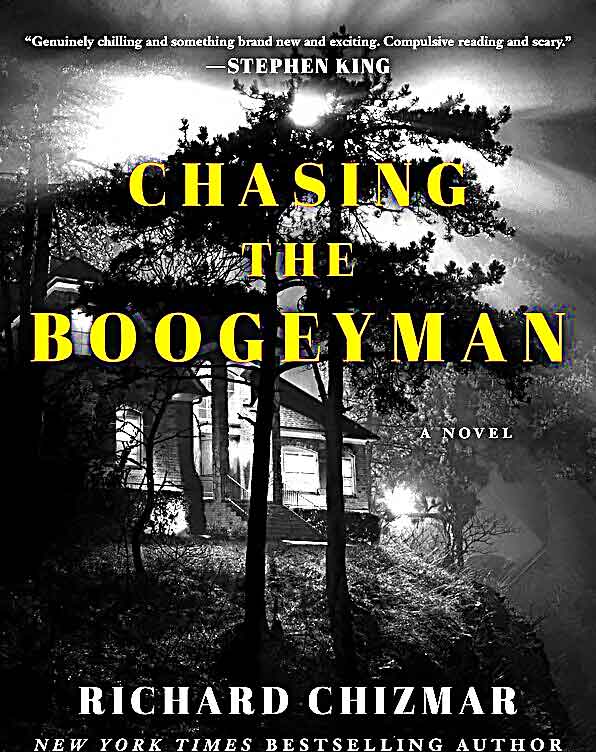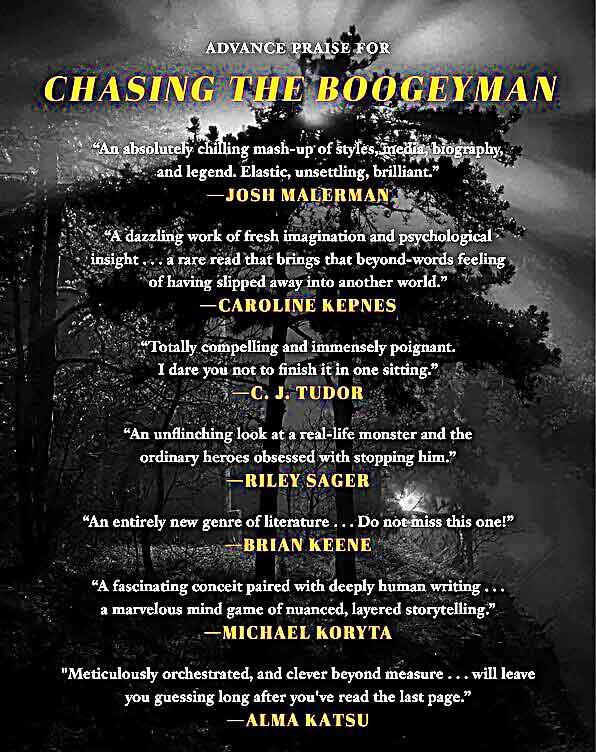 By RICHARD CHIZMAR (Gallery Books; 2021)
By RICHARD CHIZMAR (Gallery Books; 2021)
The first solo novel by Cemetery Dance editor Richard Chizmar was this unique account of crime and detection, which blends autobiography and crime fiction. Fictionalized memoirs certainly aren’t new, but what distinguishes this one is that Chizmar is upfront about his inventions (unlike the others, such as CONFESSIONS OF A DANGEROUS MIND and A MILLION LITTLE PIECES, whose authors waited until after their books were published to confess that not everything in them was truthful).
…this unique account of crime and detection, which blends autobiography and crime fiction.
Chizmar does nonetheless go to great lengths to convince us of the reality of his imaginings. Included is a forward by the true crime specialist James Renner that compounds the fictional ruse, numerous interview transcriptions and staged photos of the principals of the case (actors, actually). There’s also, however, a lengthy afterward detailing the book’s fictional and non-fictional elements, so nobody can say Chizmar doesn’t play fair.
Fictionalized memoirs certainly aren’t new, but what distinguishes this one is that Chizmar is upfront about his inventions…
The setting, and true main character, is the author’s hometown of Edgewood, Maryland, where according to this book a serial killer was active during the summer and autumn of 1988. That was also an important time in Chizmar’s life, as he, at age 22, had just finished college and moved back home with his parents, in order to put together the premiere issue of Cemetery Dance and, in early ‘89, marry his high school sweetheart.
 The first of the killings, of a young girl abducted from her bedroom in the middle of the night, occurs not far from Chizmar’s parents’ house. Three more follow, plunging Edgewood’s citizens into panic and apprehension. Chizmar and a fellow obsessive named Carly Albright do some amateur sleuthing that appears to inflame the killer, who takes to bombarding Chizmar with hang-up calls and scrawling an ominous message on Albrigt’s front porch. There are, however, no immediate leads to the killer’s identity, and it seems the case is destined to join those of the Green River and Zodiac killings in the annals of unsolved American murder sprees, but some decades-after-the-fact surprises are in store.
The first of the killings, of a young girl abducted from her bedroom in the middle of the night, occurs not far from Chizmar’s parents’ house. Three more follow, plunging Edgewood’s citizens into panic and apprehension. Chizmar and a fellow obsessive named Carly Albright do some amateur sleuthing that appears to inflame the killer, who takes to bombarding Chizmar with hang-up calls and scrawling an ominous message on Albrigt’s front porch. There are, however, no immediate leads to the killer’s identity, and it seems the case is destined to join those of the Green River and Zodiac killings in the annals of unsolved American murder sprees, but some decades-after-the-fact surprises are in store.
Chizmar may lather on the small town nostalgia a bit too thickly, with nearly every page containing a misty-eyed childhood remembrance (with, as is increasingly becoming the case, the 1970s treated in the way authors used to treat the 1930s, ‘40s and ‘50s). Still, it’s that mixture of autobiographical sincerity and “true” crime trappings that render this book unique, with the minutiae of life in Edgewood past and present (which includes much bullshitting with friends and frequent trips to 7-11) rubbing up against a depiction of psychotic insanity that’s never less that fully engrossing. Think IN COLD BLOOD meets DANDELION WINE, a mixture that somehow works.
